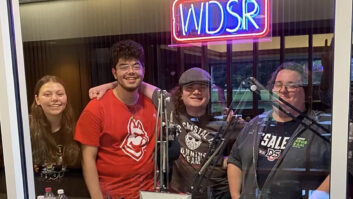(click thumbnail)In 1995 I was asked to review a new digital restoration software, Dcart, for Diamond Cut Audio Restoration Tools, from Tracer Technologies. After testing the software for several weeks, I felt the software was not ready for professional applications.
Since then the DC restoration software has made several quantum leaps. The latest versions are DC Five and DC Live 5.0.
Ready to roll
The main differences between the two products are the price – $199 for DC Five, $1,399 for DC Live – and the addition of several forensic tools in DC Live designed for specialized applications such as law enforcement and scientific research.
Product CapsuleThumbs Up:
Great manual
Lots of Presets
Choice of screen editing modes
New Impulse Filter
Vox/timer recording
Lots of digital tools
Thumbs Down:
DirectX support iffy for some third-party programs
Price: DC Five: $199; DC Live: $1,399
Contact: Tracer Technologies in York, Pa., at (717) 764 9240 or visit www.tracertek.com
What is new in these latest versions? For starters, DC Five includes the Live Preview feature previously available only in the more expensive DC Live. This allows the user to string together any of the filters and then preview the incoming signal to the sound card in real time.
A radio station could run its turntables through a computer sound card and play LPs right over the air digitally restored in real time. Rather than taking the time to transfer a vintage record library of thousands of albums to CD and digitally restoring them one at a time, they could just play the original LPs live through the computer using the DC Five software. The pops and clicks and surface noise will be removed as the albums are playing.
How well does this feature work? Very well. Depending on the computer processing power, there may be a slight latency (delay between the original sound and the restored sound). In addition, because of the complexity of the algorithms, the user may not be able to apply the impulse filters as aggressively as when digitally restoring a WAV file.
Welcome feature
The feature that I welcome most is Fast Edit. In previous editions, DC software displayed dual files on the screen that required a new file to be created each time a process was applied. This is now called the Classic mode. I always felt it slowed down the work process.
While the Classic editing mode is still available, I suspect that most users will opt for the new Fast Edit mode, which applies a new process directly to a sound file. A complete undo list is provided so that you can readily revert to (or compare) an earlier version.
Surprisingly, it is also possible to go back into the edit history and redo just a portion of the file without changing the subsequent processing that has already been done to the rest of the file. This is a real time-saver.
A new EZ Impulse Noise Filter has been added. The DC software already had one of the most comprehensive impulse noise filter sets that I have used with special algorithms for 78 rpm, vinyl and even a High Quality mode. These impulse filters are still available under the Expert Impulse Filter.
The EZ Impulse filter has only two sliders: Scratch (for larger pops and clicks) and Crackle (for smaller clicks and crackle). Unlike the Expert Impulse Filter, the EZ Impulse Filter can be set quickly, with a minimum of trial and error. The former is optimized for 44.1 kHz files while the latter is optimized for 96 kHz files.
New as well are Vox and Timer Recording options. One can set the record mode to start and stop automatically based on the level of the input signal to the computer sound card. The software will start recording when it sees a certain level and stop when the sound falls below the prescribed level. Or one can set a timer to start and stop the recording. Either way, one can record audio on an unattended computer. A radio station could use this feature to record feeds coming off a satellite, for instance.
And finally someone has added a feature that I have long been waiting for: A Filter Sweeper. What, you may well ask, is that? And why is it helpful?
The Filter Sweeper allows you to apply either a Low-Pass, High-Pass or Notch filter to a sound file (or portion of a sound file) with differing degrees of frequency attenuation from start to finish.
Here is example of where it might be used: 16-inch electrical transcriptions (78s, and other records, too) often reduced the high-frequency response of the cutting head as it approached the center of the transcription. This caused a discernible and disconcerting difference in sound quality between the beginning and end of the ET.
With the filter sweeper, you can match the end to the beginning by using a Low-Pass Filter setting that attenuates the sound at the beginning of the file to the same degree that the original recording equalization attenuated it at the end of the recording.
As the Filter Sweeper is applied to the sound file, the attenuation gradually is reduced until eventually there is no attenuation. The result is a recording the sound quality of which is uniform from beginning to end. Until now there was no good way to correct such problems. There are other uses for this unique filter, as well.
Everything I have mentioned is available in both DC Five and DC Live 5.0. But there is at least one filter in DC Live that should be of interest to anyone specializing in restoring very old and noisy recordings.
The Adaptive Normalize Filter has the ability to literally pull sounds out of noise that is as high or higher than the sound you are trying to hear. I tried it on a 1930 direct aluminum ET and was absolutely amazed at how well it was able to reject the noise while preserving the sound. No other filter that I have used has even come close to producing such results.
Bottom line
I’ve listed just few of my favorite new features in this amazing software. The bottom line is this: most digital editing software contains some restoration tools; DC Five and DC Live 5.0 are designed for digital restoration and contain just about any conceivable tool that you could ask for or think of to do the job.
Not only is the price of DC Five modest, but so also are the minimum computer requirements: 200 MHz Pentium, Windows 98 SE, 2000, ME or XP, standard RAM and hard disk, as well as a good sound card.













